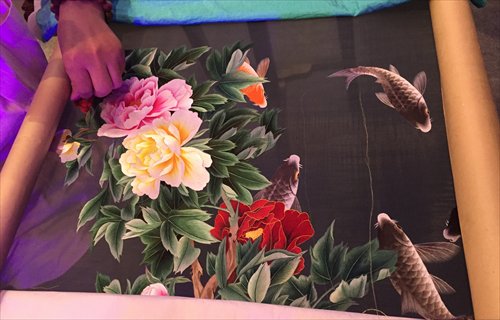
From the People's Daily App.
This is Story in the Story.
China's four great handicraft heritages are embroidery, lacquerware, porcelain, and sculptures.
Shu embroidery has been known as 'a treasure of Sichuan' ever since the Han Dynasty. It reached its peak during the Song Dynasty (960-1279).
Chengdu, the capital city of Sichuan Province, occupies a significant spot among China's intangible heritage map as it is the epicenter of the ancient craft of Shu Embroidery.
As one of the four renowned embroidery styles in China, Shu Embroidery entered the National Intangible Cultural Heritage in 2006, and then almost disappeared as very few were familiar with its complicated technique.
In 2009, the local government started providing training courses for young people. It also allocated over 20 million yuan to build the largest gallery of Shu Embroidery in the world.
"The Shu Embroidery employs over a hundred ways of stitching, 30 of which are in regular use. Sometimes young people, who are often restless, are reluctant to take on the craft,” said artist Chen Xiaoya.
Today’s Story in the Story looks at how Shu embroidery is being preserved and handed down to China’s younger generations.

An example of traditional Sichuan embroidery. (Photo: Global Times)
Meng Dezhi, 58, is a national-level intangible cultural heritage inheritor of Shu embroidery.
Born to a family of embroiderers, she was one of the most talented employees at the Chengdu Shu embroidery factory. However, faced with the market impacts brought by cheap industrial products made by modern machines, the factory closed down in 2005.
In order to make a living, Meng rented a small space of 10 square meters to teach Shu embroidery skills.
When the district government in Chengdu learned about it, it provided 70,000-yuan venture capital for a new workshop. Meng used the workshop to recruit laid-off workers to study Shu embroidery.
Today, Meng has established her own company and has opportunities to cooperate with several famous international fashion houses.
She has also established teaching bases to popularize the culture of Shu embroidery in universities and residential communities.
At the end of 1970s, the countryside in Western Sichuan was almost a household needle worker with a population of 45,000, which was 15 times the number of employees in embroidery factories.
In addition to dozens of varieties such as embroidered quilt, pillowcase, headscarf, handkerchief, shirt and tablecloth, they also actively produce raw textile embroidery pieces and embroidered screen for export. Embroidery still maintains strong local characteristics.

Two men use a traditional Sichuan weaving machine on Friday. (Photo: Global Times)
After 1981, Shu embroidery made great progress. Apart from the workers specializing in embroidery at the Shu embroidery factory, the number of people processing embroidery in rural suburbs and counties has rapidly increased to 7,000 and 8,000.
Peng Lin’s grandfather, Peng Yongxing, became China's first State-level master of Sichuan embroidery in 1988.
When she was 7, she watched her grandfather work at home and showed a keen interest.
When she was 14, her father, Peng Shiping, a provincial-level master of Shu embroidery, began teaching her to embroider flowers, grass, and birds.
She quit a better paying job as an English interpreter in a luxury hotel to start working at the museum in April last year.
Despite being pregnant, Peng spends about 30 minutes on the subway and walks about 20 minutes to the museum and home each day.
According to Xiang Zhaolun, vice-minister of culture, young people do not want to learn or inherit intangible cultural heritage because there are few buyers for their products and they cannot make ends meet.
But some young people like Peng have learned from family members and are pillars in their fields.
But despite its labor-intensive nature and the march of modernization and industrialization, Peng is confident that the craft will survive.
“We’ve developed a sustainable system of recruiting new blood from schools. The younger generation is willing to take over our jobs,” says Peng, 54, an employee of the Shu Brocade Institute in Chengdu.
While a less than 1-square-meter piece of embroidery usually takes him a year of intense work, once it is done, it can sell for about 500,000 yuan.
"In the early days, I set up the company just for survival, but now I really feel that I have the responsibility to pass on Shu embroidery skills to young people, to let it run from generation to generation," Meng said.
(Produced by Nancy Yan Xu, Lance Crayon, Brian Lowe and Paris Yelu Xu. Music by: bensound.com. Text from China Daily.)


